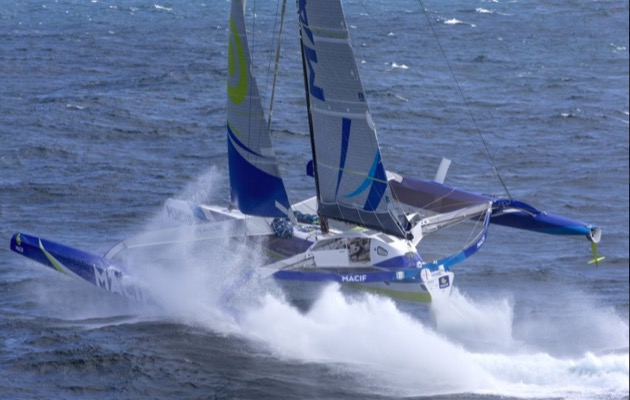Take a look aboard François Gabart's 100ft trimaran MACIF, in which he hopes to break the solo round the world record
Before he left on his first solo transatlantic race this weekend, French sailor François Gabart allowed us this look aboard his 100ft/31m trimaran MACIF.
Designed by VPLP, MACIF has been built for the 33-year-old Gabart to race in events such as the solo The Transat bakerly from Plymouth to New York and to try to break the solo round the world record. Gabart, the last winner of the Vendée Globe round the world race, will be attempting the record currently held by Francis Joyon next year.
MACIF is big step forward from early solo multihulls such as Joyon’s IDEC, Ellen MacArthur’s B&Q and Thomas Coville’s Sodebo, as our video shows.
MACIF is wider and heavier, with more righting moment.
For example, while the original Sodebo was the same length, but was 16.5m wide, displaced around 11 tonnes with upwind/downwind sail area of 350/520sqm, the new MACIF is 21m across, weighs 14.5 tonnes and has sail areas of 430/650sqm.
MACIF has a huge rotating wingmast that be canted to windward to generate more power while reducing the downward force on the leeward float.

Halyards and controls abaft the wingmast
The boat also has a retractable V-shaped foil in each float and the pitch can be adjusted manually (automatic ride correction is banned in this case – but more of that later).
MACIF represents a departure in how these multihulls are being sailed. Gabart has both steering positions inside a cabin, in an area that encompasses winches and grinders. This area looks something like a ship’s bridge and abaft this is cuddy cabin on the same level with a bunk for him, a seat and nav area.

One of two wheels, and winches set on the aft beam of MACIF
This means that Gabart can rest or navigate and yet be two steps away from vital controls. Most of his food and tools are stored here too for a shortish race such as The Transat (8-10 days) so he will have little need to go inside the main hull.
Gabart says he will spend “95% of my time” inside this very sheltered area. The furling headsails and main can be controlled from here and he will have to go outside only to hoist or take down the larger headsails. For this he must slow the boat.
Now that these trimarans can do sustained speeds of 40 knots, the solo sailors need safe shelter and must be very cautious outside it.
There is always a risk of capsize, especially in volatile conditions, for example following the passage of a cold front. The mainsheet is on a hydraulic release ram which can be controlled with a line leading to Gabart’s pipe cot – it is the small blue line in the photo below.

When he’s resting, sheets can be also lead back to cam cleats in the doorway of his cabin so that with one flick from his lying position they can be released. There are also cam cleats on the top of the grinder pedestals, which you can see in the video.
Between the cams there is pin which is activated by the boat’s Upside Up system, an electronic system that allows the skipper to set the maximum heel angle or pitch angle. If the boat exceeds the set limit the pin is pushed up, forcing the sheet out of the cleat and releasing the line.

One of two grinder pedestals on MACIF. Note the cam cleats which can be released by the ‘Upside Up’ system
Gabart admits that on his first solo race he is “out of his comfort zone” but the lessons learned in tackling a succession of weather systems will be invaluable.
He believes that he is on the cusp of a major revolution in solo ocean racing, which will see boats like his flying on foils right the way across the Atlantic, and eventually round the world. “This is huge. There is no reason why these boats cannot fly in five, ten or 20 years and the increase in speed will be huge,” he says.

Forward visibility in the cabin area on MACIF
He firmly believes the automated ‘ride flight’ controls that we are seeing developed in the America’s Cup will come to these multihulls and will be part of the answer. They are currently prohibited, but other teams are pushing for them too.
The number of big trimarans making up the so-called ‘Ultime’ class is going to grow, forming around a new 31m box rule. New boats are also in the pipeline for Edmond de Rothschild/Gitana and Banque Populaire.
Automated systems to aid foiling will be very costly for teams to develop and will push up the price, but the ability to control the rake adjustment of foils and rudders could make foil racing safer and will inevitably come.
“There will be so many things in the next ten years,” says Gabart. “I am lucky. I have just arrived as the revolution has been done and for offshore sailing we have more years to learn how to fly. This is just the start.”

Wave piercing bows – MACIF’s starboard float




